当前位置:
X-MOL 学术
›
J. Comput. Chem.
›
论文详情
Our official English website, www.x-mol.net, welcomes your
feedback! (Note: you will need to create a separate account there.)
Simulating ion channel activation mechanisms using swarms of trajectories
Journal of Computational Chemistry ( IF 3.4 ) Pub Date : 2019-11-19 , DOI: 10.1002/jcc.26102 Bogdan Lev 1 , Toby W Allen 1
Journal of Computational Chemistry ( IF 3.4 ) Pub Date : 2019-11-19 , DOI: 10.1002/jcc.26102 Bogdan Lev 1 , Toby W Allen 1
Affiliation

|
Atomic‐level studies of protein activity represent a significant challenge as a result of the complexity of conformational changes occurring on wide‐ranging timescales, often greatly exceeding that of even the longest simulations. A prime example is the elucidation of protein allosteric mechanisms, where localized perturbations transmit throughout a large macromolecule to generate a response signal. For example, the conversion of chemical to electrical signals during synaptic neurotransmission in the brain is achieved by specialized membrane proteins called pentameric ligand‐gated ion channels. Here, the binding of a neurotransmitter results in a global conformational change to open an ion‐conducting pore across the nerve cell membrane. X‐ray crystallography has produced static structures of the open and closed states of the proton‐gated GLIC pentameric ligand‐gated ion channel protein, allowing for atomistic simulations that can uncover changes related to activation. We discuss a range of enhanced sampling approaches that could be used to explore activation mechanisms. In particular, we describe recent application of an atomistic string method, based on Roux's “swarms of trajectories” approach, to elucidate the sequence and interdependence of conformational changes during activation. We illustrate how this can be combined with transition analysis and Brownian dynamics to extract thermodynamic and kinetic information, leading to understanding of what controls ion channel function. © 2019 Wiley Periodicals, Inc.
中文翻译:

使用大量轨迹模拟离子通道激活机制
由于在广泛的时间尺度上发生的构象变化的复杂性,蛋白质活性的原子级研究是一项重大挑战,通常大大超过即使是最长的模拟。一个主要的例子是蛋白质变构机制的阐明,其中局部扰动在整个大分子中传递以产生响应信号。例如,大脑突触神经传递过程中化学信号到电信号的转换是通过称为五聚体配体门控离子通道的特殊膜蛋白实现的。在这里,神经递质的结合导致整体构象变化,从而在神经细胞膜上打开一个离子传导孔。X 射线晶体学产生了质子门控 GLIC 五聚体配体门控离子通道蛋白的开放和关闭状态的静态结构,允许进行原子模拟,揭示与激活相关的变化。我们讨论了一系列可用于探索激活机制的增强采样方法。特别是,我们描述了基于 Roux 的“轨迹群”方法的原子串方法的最新应用,以阐明激活过程中构象变化的顺序和相互依赖性。我们说明了如何将其与跃迁分析和布朗动力学相结合以提取热力学和动力学信息,从而了解控制离子通道功能的因素。© 2019 威利期刊公司。允许进行原子模拟,以揭示与激活相关的变化。我们讨论了一系列可用于探索激活机制的增强采样方法。特别是,我们描述了基于 Roux 的“轨迹群”方法的原子串方法的最新应用,以阐明激活过程中构象变化的顺序和相互依赖性。我们说明了如何将其与跃迁分析和布朗动力学相结合以提取热力学和动力学信息,从而了解控制离子通道功能的因素。© 2019 威利期刊公司。允许进行原子模拟,以揭示与激活相关的变化。我们讨论了一系列可用于探索激活机制的增强采样方法。特别是,我们描述了基于 Roux 的“轨迹群”方法的原子串方法的最新应用,以阐明激活过程中构象变化的顺序和相互依赖性。我们说明了如何将其与跃迁分析和布朗动力学相结合以提取热力学和动力学信息,从而了解控制离子通道功能的因素。© 2019 威利期刊公司。我们描述了基于 Roux 的“轨迹群”方法的原子串方法的最新应用,以阐明激活过程中构象变化的顺序和相互依赖性。我们说明了如何将其与跃迁分析和布朗动力学相结合以提取热力学和动力学信息,从而了解控制离子通道功能的因素。© 2019 威利期刊公司。我们描述了基于 Roux 的“轨迹群”方法的原子串方法的最新应用,以阐明激活过程中构象变化的顺序和相互依赖性。我们说明了如何将其与跃迁分析和布朗动力学相结合以提取热力学和动力学信息,从而了解控制离子通道功能的因素。© 2019 威利期刊公司。
更新日期:2019-11-19
中文翻译:

使用大量轨迹模拟离子通道激活机制
由于在广泛的时间尺度上发生的构象变化的复杂性,蛋白质活性的原子级研究是一项重大挑战,通常大大超过即使是最长的模拟。一个主要的例子是蛋白质变构机制的阐明,其中局部扰动在整个大分子中传递以产生响应信号。例如,大脑突触神经传递过程中化学信号到电信号的转换是通过称为五聚体配体门控离子通道的特殊膜蛋白实现的。在这里,神经递质的结合导致整体构象变化,从而在神经细胞膜上打开一个离子传导孔。X 射线晶体学产生了质子门控 GLIC 五聚体配体门控离子通道蛋白的开放和关闭状态的静态结构,允许进行原子模拟,揭示与激活相关的变化。我们讨论了一系列可用于探索激活机制的增强采样方法。特别是,我们描述了基于 Roux 的“轨迹群”方法的原子串方法的最新应用,以阐明激活过程中构象变化的顺序和相互依赖性。我们说明了如何将其与跃迁分析和布朗动力学相结合以提取热力学和动力学信息,从而了解控制离子通道功能的因素。© 2019 威利期刊公司。允许进行原子模拟,以揭示与激活相关的变化。我们讨论了一系列可用于探索激活机制的增强采样方法。特别是,我们描述了基于 Roux 的“轨迹群”方法的原子串方法的最新应用,以阐明激活过程中构象变化的顺序和相互依赖性。我们说明了如何将其与跃迁分析和布朗动力学相结合以提取热力学和动力学信息,从而了解控制离子通道功能的因素。© 2019 威利期刊公司。允许进行原子模拟,以揭示与激活相关的变化。我们讨论了一系列可用于探索激活机制的增强采样方法。特别是,我们描述了基于 Roux 的“轨迹群”方法的原子串方法的最新应用,以阐明激活过程中构象变化的顺序和相互依赖性。我们说明了如何将其与跃迁分析和布朗动力学相结合以提取热力学和动力学信息,从而了解控制离子通道功能的因素。© 2019 威利期刊公司。我们描述了基于 Roux 的“轨迹群”方法的原子串方法的最新应用,以阐明激活过程中构象变化的顺序和相互依赖性。我们说明了如何将其与跃迁分析和布朗动力学相结合以提取热力学和动力学信息,从而了解控制离子通道功能的因素。© 2019 威利期刊公司。我们描述了基于 Roux 的“轨迹群”方法的原子串方法的最新应用,以阐明激活过程中构象变化的顺序和相互依赖性。我们说明了如何将其与跃迁分析和布朗动力学相结合以提取热力学和动力学信息,从而了解控制离子通道功能的因素。© 2019 威利期刊公司。











































 京公网安备 11010802027423号
京公网安备 11010802027423号